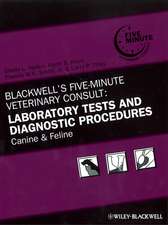Blackwell′s Five–Minute Veterinary Practice Management Consult
en Hardback – 15 oct 2006
Preț: 543.96 lei
Preț vechi: 706.44 lei
-23% Nou
Puncte Express: 816
Preț estimativ în valută:
104.10€ • 113.04$ • 87.44£
104.10€ • 113.04$ • 87.44£
Carte disponibilă
Livrare economică 01-15 aprilie
Preluare comenzi: 021 569.72.76
Specificații
ISBN-13: 9780781759847
ISBN-10: 0781759846
Pagini: 654
Dimensiuni: 225 x 289 x 42 mm
Greutate: 2.07 kg
Editura: Blackwell Pub Professional
Locul publicării:Hoboken, United States
ISBN-10: 0781759846
Pagini: 654
Dimensiuni: 225 x 289 x 42 mm
Greutate: 2.07 kg
Editura: Blackwell Pub Professional
Locul publicării:Hoboken, United States
Public țintă
practicing veterinariansDescriere
Blackwell’s Five–Minute Veterinary Practice Management Consult is a comprehensive, one–stop reference text on all things management related, from understanding the marketplace in which veterinarians practice, to appreciating hospital finances, to the nuts and bolts of marketing services for a veterinary practice. Topics are covered in a thorough but concise format and provide invaluable information for practice owners, administrators, associates and staff. Key Features: · follows the popular Five–Minute Veterinary Consult structured format · consistency of presentation makes for easy information retrieval · focus is on practical rather than theoretical solutions for veterinary practice issues · Provides examples within relevant topics Sections include: · The veterinary marketplace · Client relationship management · Communications · Financial management · Cash management · Human resources · Marketing management · Operations management · Administrative management · Practice safety · Legal Issues · Planning & Decision–making · Facility management, design and construction Plus, appendices, list of abbreviations, glossary, and more!
Textul de pe ultima copertă
Blackwell’s Five–Minute Veterinary Practice Management Consult is a comprehensive, one–stop reference text on all things management related, from understanding the marketplace in which veterinarians practice, to appreciating hospital finances, to the nuts and bolts of marketing services for a veterinary practice. Topics are covered in a thorough but concise format and provide invaluable information for practice owners, administrators, associates and staff. Key Features: · follows the popular Five–Minute Veterinary Consult structured format · consistency of presentation makes for easy information retrieval · focus is on practical rather than theoretical solutions for veterinary practice issues · Provides examples within relevant topics Sections include: · The veterinary marketplace · Client relationship management · Communications · Financial management · Cash management · Human resources · Marketing management · Operations management · Administrative management · Practice safety · Legal Issues · Planning & Decision–making · Facility management, design and construction Plus, appendices, list of abbreviations, glossary, and more!
Cuprins
Chapter 1 Marketplace. 1.1 Veterinary Demographics. 1.2 Today’s Pet Owner. 1.3 Models of Veterinary Practice. 1.4 Trade Areas and Region of Influence. 1.5 The Differing Needs of Practice Teammates. 1.6 Personality Profiling. 1.7 Generational Differences. 1.8 Stakeholders and Strategic Partners. 1.9 Functioning as a Healthcare Team. 1.10 Practice Management Support Professionals. 1.11 Veterinary Staff. 1.12 Value Disciplines. 1.13 Networking. 1.14 Specialty and Emergency Centers. 1.15 Mergers and Acquisitions. 1.16 Human–Animal Bond. 1.17 IT in Veterinary Medicine. 1.18 Value Chain Management. 1.19 Time Value of Money. 1.20 Equine Practice Management. 1.21 Costs of Doing Business in a Veterinary Hospital. 1.22 Nonprofit Hospitals. Chapter 2 Client Relationship Management. 2.1 Compliance. 2.2 The Basics of Client Service. 2.3 Client Service Strategies. 2.4 Hospital Image. 2.5 Creating a Client–Centered Hospital. 2.6 Client Perception and Learning. 2.7 Telephone Service Management. 2.8 Effective Doctor–Client Relationship. 2.9 Client Appointment Scheduling. 2.10 Measuring Client Satisfaction. 2.11 Client Retention. 2.12 Client Reminder Systems. 2.13 Preparing Clients for Continued Excellence in Health Care. 2.14 Practice Web Sites. 2.15 Maintaining Regular Client Contact. 2.16 Hi–Tech versus Hi–Touch. Chapter 3 Communications. 3.1 Effective Client Communication. 3.2 Email Correspondence. 3.3 Translating Medicalese. 3.4 Speaking as a Professional. 3.5 Non–Verbal Communication. 3.6 Reflective Listening. 3.7 Ensuring Client Comprehension. 3.8 Dealing With an Angry Client. 3.9 Dealing With a Grieving Client. 3.10 Discussing Parasite Control. 3.11 Discussing Vaccination Schedules. 3.12 Discussing Pain Management. 3.13 Discussing Dental Health. 3.14 Discussing Behavior. 3.15 Discussing Diet and Nutrition. 3.16 Discussing Finances. 3.17 Shared Decision Making. 3.18 Delivering Bad News. Chapter 4 Financial Management. 4.1 Getting the Most Out of Your Accounting Professional. 4.2 Making Valid Comparisons Between Practices and Services. 4.3 Financial Statements. 4.4 Capitalization and Depreciation. 4.5 Measures of Liquidity, Solvency, and Profitability. 4.6 Analyzing Client Transactions. 4.7 Data You Should Be Reviewing Regularly. 4.8 Breakeven Analysis. 4.9 Benchmarking. 4.10 Activity–Based Costing and Cost Allocation. 4.11 Pricing Strategies and Decisions. 4.12 Cost–Plus Pricing. 4.13 Internal Accounting Controls. 4.14 Medical Metrics. 4.15 Return on Investment From Practice Ownership. 4.16 Perquisites (Perks) of Practice Ownership. 4.17 Accounting Closing Processes. 4.18 Tax Planning––US. Chapter 5 Cash Management. 5.1 Revenue Streams in Veterinary Practice. 5.2 Expenses in Veterinary Practice. 5.3 Increasing the Top Line in Practice. 5.4 Improving the Bottom Line in Practice. 5.5 Cash Control: Preventing Theft. 5.6 Getting Paid for Services Rendered. 5.7 Managing Accounts Receivable. 5.8 Credit and Collections. 5.9 Payroll Management. 5.10 Borrowing Money. 5.11 Revenue Budgets and Forecasts. 5.12 Managing General and Administrative Expenses. 5.13 Credit Alternatives: Third–Party Payments. 5.14 Pet Insurance. 5.15 Buy Versus Lease. 5.16 Buy Versus Lease: Accountant’s Perspective. 5.17 Ordering Inventory Economically. 5.18 Discounting. 5.19 Practice Reinvestment. 5.20 The EFT Payment Process. 5.21 Controlling Cash Flow: Budgeting. Chapter 6 Human Resources. 6.1 Compensation. 6.2 Benefits. 6.3 Wage and Benefit Summaries: The Whole Package. 6.4 Employee Bonus Criteria Design. 6.5 Other Employee–Related Costs. 6.6 Effective Interviewing. 6.7 Screening Potential Hires. 6.8 Staff Orientation. 6.9 Staff Training. 6.10 Empowering Staff. 6.11 Motivating Staff. 6.12 Mentoring. 6.13 Making Meetings work. 6.14 Staff Turnover and Retention. 6.15 Measuring Your HR Performance. 6.16 Conflict Resolution. 6.17 Office Politics. 6.18 Staff Scheduling Options. 6.19 Staff Performance Evaluations. 6.20 Terminating Staff. 6.21 Burnout. Chapter 7 Marketing Management. 7.1 Fair and Ethical Competition and Marketing. 7.2 The Big Picture: Marketing, Advertising, Promotion and Public Relations. 7.3 Better Meeting the Needs of Existing Clients (Internal Marketing). 7.4 Attracting New Clients (External Marketing). 7.5 Branding. 7.6 Product and Service Positioning. 7.7 Practice Differentiation. 7.8 Giving Clients What They Want Most. 7.9 Marketing Tools. 7.10 Target Marketing. 7.11 Demographic Analysis. 7.12 Marketing Plan. 7.13 Measuring Your Marketing Performance. 7.14 Internet Marketing. 7.15 Pamphlets, Brochures, and Newsletters. 7.16 Paid Advertising. 7.17 Professional Promotion and Public Relations. 7.18 Outbound Calls. 7.19 Soliciting Client Feedback. 7.20 Dealing With the Media. 7.21 Dealing With a Crisis. Chapter 8 Operations Management. 8.1 Patient Documentation and Medical Records. 8.2 Patient and Procedure Logs. 8.3 Medical Protocols. 8.4 Effective Inventory Management. 8.5 Profit Centers. 8.6 Medical Equipment and Fixtures. 8.7 Pharmacy Management (as a Profit Center). 8.8 Kennel Management (as a Profit Center). 8.9 Waste Management. 8.10 Continuity of Care. 8.11 Selecting Computer hardware. 8.12 Selecting Computer Software. 8.13 Internet Security, Viruses, Worms, and Adware. 8.14 Continuous Quality Improvement. 8.15 Value–Added Analysis. Chapter 9 Administrative Management. 9.1 Workplace Management. 9.2 Leadership. 9.3 Emotional Intelligence. 9.4 Working in Teams. 9.5 People Management. 9.6 Procedure Manuals. 9.7 Employee Policy Manual. 9.8 Practice Insurance Needs. 9.9 Enhancing Doctor Productivity. 9.10 Enhancing Staff Productivity. 9.11 Staff Performance Planning (Proactive Goal Setting). 9.12 Staffing Budgets. 9.13 Personnel Records. 9.14 Archiving and Backup. 9.15 When To Hire an Office Manager/Administrator. 9.16 Retail Sales–Merchandising Support. 9.17 Continuing Education Expenses. 9.18 Not–for–Profit Foundation. 9.19 Internet Use Policy. 9.20 Privacy Policy and Confidentiality. 9.21 Negotiating 101. Chapter 10 Practice Safety. 10.1 Basics of Meeting Practice Safety Requirements. 10.2 Practice Safety Needs. 10.3 Radiation Safety. 10.4 Client Safety. 10.5 Implementing a Safety Plan. 10.6 Hospital Safety Manual. 10.7 Work–Related Accidents and Worker’s Compensation. 10.8 Security Issues for Hospital and Staff. 10.9 Emergency Plans. 10.10 Disaster Preparedness. 10.11 Controlled Substances. 10.12 Adverse Drug Event Reporting. Chapter 11 Legal Issues. 11.1 Legal Practice Needs and Dealing With Lawyers. 11.2 Guardianship. 11.3 Informed Consent. 11.4 Malpractice. 11.5 Unprofessional Conduct. 11.6 Buy/Sell Agreements. 11.7 Employment Contracts. 11.8 Partnership Agreements. 11.9 Non–Competition. 11.10 Legal Duty To Refer. 11.11 Independent Contractor Versus Employee. 11.12 Workplace Harassment. 11.13 Disability Law. 11.14 Fair Labor Standards. 11.15 Extralabel Drug Use. 11.16 Legal Duty for Handling Abandoned Animals. 11.17 Animal Abuse. 11.18 Pet Trusts and Wills. Chapter 12 Planning and Decision Making. 12.1 Career Planning. 12.2 Professional Development Plans. 12.3 Resume and Cover Letter. 12.4 Curriculum Vitae. 12.5 Mission and Vision Statements. 12.6 Business Plans. 12.7 Strategic Profit Planning. 12.8 What Is This Practice Worth?. 12.9 Business Structure. 12.10 Buying a Practice. 12.11 From Associate to Owner. 12.12 Selling a Practice. 12.13 Succession Planning. 12.14 Retirement Planning. 12.15 Gifting Practice Ownership. 12.16 Your Next Career. 12.17 Debt Management. 12.18 Risk Management Issues. 12.19 Identifying and Solving Problems. 12.20 Tax–Deferred Real Estate Exchanges. 12.21 Business Contingency Planning. Chapter 13 Facility Management, Design, and Construction. 13.1 Selecting a Site. 13.2 Financing Basics. 13.3 Asset Ownership. 13.4 How Large Should a Clinic Be?. 13.5 Client/Patient Flow. 13.6 Managing Construction Costs. 13.7 The Construction Process and Working With Architects. 13.8 Leasehold Improvements in Rental Facility. 13.9 Practice Renovations. 13.10 Noise and Odor Control. 13.11 Heating, Ventilation, and A/C. 13.12 Flooring. 13.13 Integrating Technology. 13.14 Referral and Emergency Facilities. 13.15 Equine Facilities. 13.16 The “Greening” of Veterinary Practice. 13.17 Pet Parks, Spas, and Luxury Accommodations. 13.18 Zoning and Permitting. Appendices. A. Sample Resume and Cover Letter. B. Curriculum Vitae. C. Business Plan. D. Marketing Plan. E. Finding More Information on Practice Management Topics. Abbreviations. Glossary. Index
Recenzii
“A powerful one–step reference on all management issues for consult practices, from understanding the marketplace in which vets practice to hospital finances, budgeting, marketing services to a vet practice, and practicing safety. From legal issues to planning, this structured guide offers a focus on practical assessments and solutions key to the vet practice.” ( Midwest Book Review , November 2008)
Notă biografică
Lowell Ackerman, DVM, DACVD, MBA, MPA. Bizvet, Inc., Westborough, Mass. www.bizvet.com




